Why Design?
Great design is no longer a nice to have for successful digital products, services and customer experiences. It's vitally important. Design brings world leading experts across the design spectrum to share their insights and expertise. If you are involved with the design of digital product or services, you can't afford to miss this one-of-a-kind Australian event. Only in Melbourne, arguably Australia's Design capital.
Who's it for?
Design is for everyone involved with the design of great products and services. From user research, to product owners and managers, UX, CX, IxD and Product Designers. Design Managers, Art and Creative Directors.
Real World Knowledge
For well over a decade, Web Directions has been holding conferences for web and digital creators, both for engineering as well design professionals.
Each of our conferences features real world, actionable knowledge, from leading practitioners, from around Australia and the world.
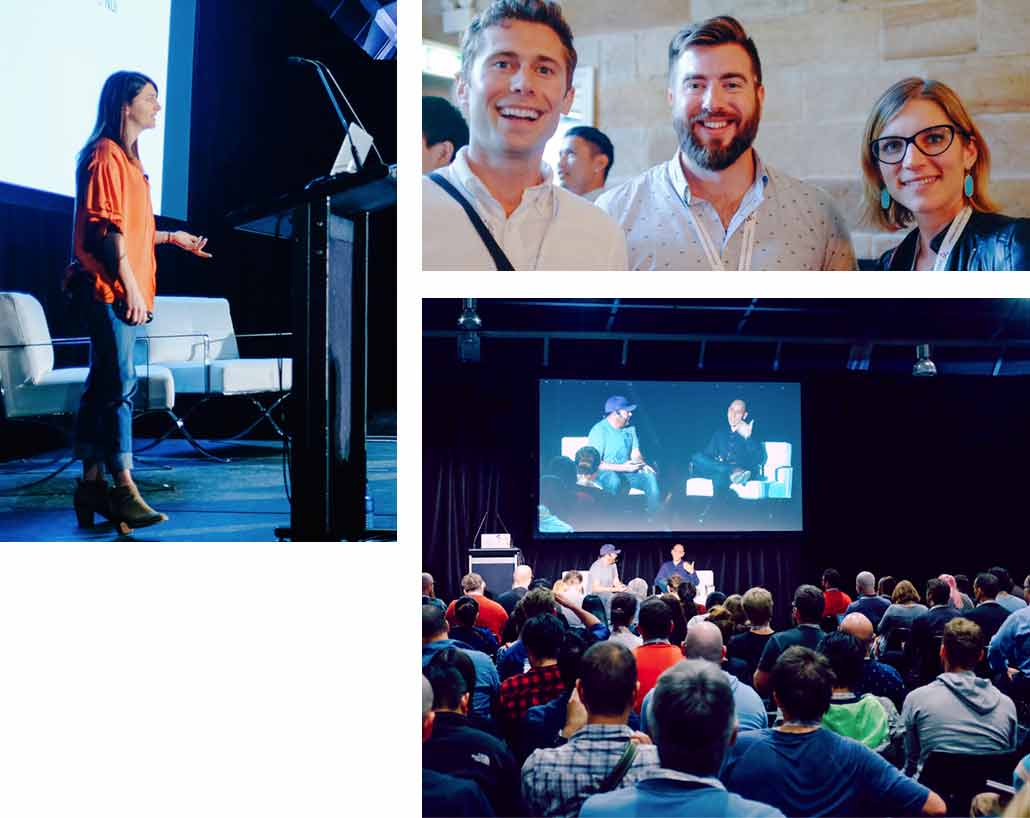
- 200+ Passionate attendees
- 20 World leading speakers
- 2 intense days
Design Leaders Conference
Modeled on our very successful Code Leaders and Culture events, in 2018 we're launching Design Leaders to be held on April 11, the day before Design. It's a single-day event focusing on the challenges facing design decision makers and leaders.
From better articulating the business value of Design, to building and leading design teams, Design Leaders is created for experienced design professionals in, or moving into management and leadership roles. Read more about Design Leaders.
Can't make it to Melbourne?
If you focus on design, but can't make it to Melbourne in April, then don't despair, the Web Directions Summit, in Sydney in November 2018 is a multi track event for the whole team, with a track especially devoted to design.
Keep up with industry news and ideas
Every weekend we round up the the best of what we've read, watched and listened to this week, across design, development, and the big ideas shaping our industry. You'll also get the first chance to register for our events, and the best offers. And you should follow us on Twitter.
Big Ideas
Start and end each day with inspiring talks from our industry's leading minds, including:

Designing Inclusive Products
Sara Wachter Boettcher Principal Rare Union
Most of us start projects with good intentions—we want to make things welcoming, seamless, and maybe even fun to use. But too often, toxic cultures within tech result in products that have all sorts of biases embedded in them: “smart scales” that assume everyone wants to lose weight, form fields that fail for queer people, résumé-reading algorithms that are biased against women, image-recognition software that doesn’t work for people of color. As tech becomes increasingly central to our users' days—and intertwined with their most intimate lives—we have more responsibility than ever to consider who could be harmed or left out by our decisions.
In this talk, we’ll take a hard look at how our industry’s culture—its lack of diversity, its “fail fast” ethos, its obsession with engagement, and its chronic underinvestment in understanding the humans it’s designing for—creates products that perpetuate bias, manipulate and harm users, undermine democracy, and ultimately wreak havoc. Then, we’ll talk about what we can do about it: how we can uncover assumptions in our work, vet product decisions against a broader range of people and situations, have difficult conversations with our teams and companies, and pursue a more ethical and inclusive way forward for our industry.
Read More

Influencing Decisions with Design Research
Stephanie Troeth Head of Design Research (ex) Telegraph Group UK
As designers, we see it as our responsibility to come up with the best solution possible to any given problem. But how well do we know the problem? Can we influence how a problem ought to be solved?
In this talk, Steph discusses about the challenges and rewards of bringing research forward in the design process—how we can better articulate the value of design through research, so that we can begin to use design research to drive the direction of organisational strategy.
Read More

Beyond words: using content strategy for better UX
Sally Bagshaw Founder Snappy Sentences
We know an important part of creating a great user experience is getting the right information to the right person, at the right time. And a clear content strategy provides the framework to make this happen. But did you know that content strategy can help with more than words? It can embed empathy into your service, architect content systems that will deliver the experience you design and build robust teams with the right skills to sustain digital products.
In this session, Sally will share some practical advice about other ways a content strategist can help with your projects, plus give you tips on incorporating content strategy into your own UX toolkit.
Read More

Designing User Experiences with Eye Tracking
Eduardo Velloso Lecturer, Researcher University of Melbourne
In recent years, we have witnessed a revolution in eye tracking technologies. Eye trackers that used to cost tens of thousands of dollars, requiring awkward head-mounts and convoluted calibration procedures now cost less than a few hundred dollars and are simple to set up and easy to use. As technology decreases in size and cost, it is easy to envision a world in which eye trackers will ship by default with interactive appliances, similarly to how any phone or laptop now comes with an integrated webcam.
This context creates a need for principles that guide the design of interactive systems that take input from the eyes. This talk will explore the principles of gaze that make it such a compelling way of interacting with computers and mobile devices.
Read More

Using Jobs To Be Done Theory in Design
David Herse Product Manager Five Good Friends
How can we design products that bring real value to users? Why do users choose one product over another? How do some products manage to disrupt and innovate while others stay stagnate? The answer lies in the ‘job’ a user is hiring a product to do. This is called Jobs To Be Done Theory.
Jobs To Be Done Theory is centred around a clear understanding of a customers’ struggle and the progress they seek in a given circumstance. A well-defined job offers a kind of innovation blueprint. To create products of real user value, designers need to fundamentally understand the reasons an individual chooses to pull a product into their lives. This talk discusses how to uncover a users ‘job’ and apply it to the design process.
Read More

Collaboration and Scale
Ben Barone-Nugent & Jamie Kimmel Content Strategy, UX Facebook
Making products that work in multiple languages isn't just about words. It's also about understanding users and their communities — and your collaborators.
Facebook places a careful emphasis on building collaborative relationships that help us serve billions of users. We'll look at how we think about design relationships, how they result in products that scale globally.
Read More

Should I really bother learning to code?
Diana MacDonald Product Designer Culture Amp
This talk will look at what you can achieve with a little bit—not a lot!—of code.With a brief look at how code in my design process has challenged my assumptions, improved accessibility, and helped me communicate with engineers. Beyond that, you'll see how to get real value of out coding skills without ever shipping production code or becoming a unicorn.
Read More

The art of mindfulness in product design
Remya Ramesh Head of Design OpenCities
Mindfulness is the ability to be fully present, aware of where we are and what we’re doing. In recent years it’s become an increasingly popular topic and moved from its deep roots in the Buddhist tradition into leadership circles, boardrooms and even primary school classrooms. But behind the hype, there’s real, tangible value - it helps you build better products by engaging in active observation, mindful listening, and conscious collaboration.
This talk will explore the concept of mindfulness and how you can apply it in the ideation, research and design phases of product development. After this session, you’ll walk away with strategies to effectively use mindfulness techniques like present-moment attention and non-judgemental awareness to transform the way you run your next user research or design critique session.
Read More

Why a poker-playing AI should have designers looking for a new job
Cory-Ann Joseph UX Lead ANZ
A 2013 report called 'The Future of Employment: How susceptible are jobs to computerisation?' left some occupations like soccer umpires feeling very vulnerable, and designers feeling very smug. However as a weird mix of content strategist, UX designer and former poker player my smug job-secure world was thrown upside down by the success of the Libratus poker AI in January of this year - the first to comprehensively beat multiple poker professionals over a series of four days.
If you’re wondering what poker has to do with design - the answer is a lot! In this talk I’ll cover why the mix of probability, pattern-matching, human behaviour and context in poker strategy is a good model for design, how game theory in poker strategy might be used to ‘solve’ design (and possibly front-end dev!), where design AI efforts are at, and why we should stop treating AI like a digital butler and start imagining the tools of the future - even it if puts you out of a job.
Read More

Designing for Voice: Alexa, Google Assistant, and beyond
Darla Sharp Voice UX Designer Google
There are few places where design is less evident than when you use a voice user interface, like the Amazon Echo or the Google home. But as anyone who has used Alexa or the Google Assistant knows, it's painfully obvious when a voice based experience is not designed well. You go nowhere, fast. It's the equivalent of a 404 page, but somehow more personally frustrating.
As a former voice designer for Alexa, and a current voice designer for the Google Assistant, I would like to talk about the ins and outs of designing for an eyes-free experience. What is voice design? What does it look like? Why is it important? What happens when you do it well? And what happens when it's not designed at all.
Read More

Design Systems at Scale
Sarah Federman Experience Designer Adobe
A design system can vastly improve your team's productivity, but most of all, it leads to better products! The challenge lies in creating a mature system and leading its adoption across the company successfully. Let's talk about how we learned to meet the needs of different designers and developers on different products, on different tech stacks. Attendees will go home with tips they can use to improve design systems of any stage.
Read More

Crafting Ethical AI Products and Services–a UX Guide
Hilary Cinis UX Group Leader Data61
Computer Scientists, software engineers and academics are currently carrying the load of responsibility for the ethical implications of AI (specifically Machine Learning) in application. As a result, AI is inferred as having its own agency. This emerging separation of technology from people is alarming, considering it is people who are making it and using to inform important decisions. This work belongs to a wider group – namely development teams and their parent organisations and key to moving forward to a positive future is having cross discipline teams making this tech, mindful ethical approaches and clear methods of communicating this process ongoing with teams, customers, clients and society.
This talk is aimed at designers and product managers and proposes an ethical framework in discovery and solutions. We look at where UX can fit in via the application of existing methods, the relationships between people including how to anticipate the power relationships and finally proposed approaches to solution design to foster trust, control and reduce the mystery of machine learning systems. A robust list of references further reading will also be provided.
Read More
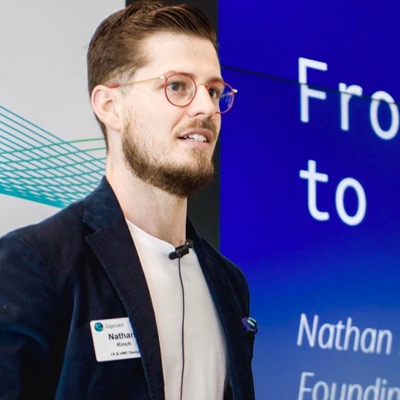
It's time to design for trust
Nathan Kinch Partner Greater Than Experience
Consumer trust is at an all time low. Questionable data practices, outdated business models and zero-sum experiences have made this so. But who is responsible for closing the gap? My experience has led me to believe it's largely the responsibility of designers.
To give designers a toolkit to make this a repeatable process, I worked together with Data Transparency Lab to develop practical plays and a take to work playbook. In this talk I'll guide the audience through the 3 plays they must make to close the data trust gap and make the trustworthiness of their experiences a sustainable competitive advantage.
Read More

Why Designers should care about blockchain
Stefan Schroeder Experience Lead SapientRazorfish
The technology revolution is here and it is not virtual reality or voice assistants: blockchain, a young industry where excitement is huge around cryptocurrency. However, blockchain is more than bitcoin and making fast money, blockchain evangelists think it can remarkably improve our life. But so far most concepts are technology driven and design in all aspects (CX, UX, Visual, Service and Product design) doesn't play a big role when people think about blockchain and was not part of the revolution so far. That's why this talk will explore the role of design in the blockchain space.
Many blockchain applications don't have an interface yet or do not have an impact on the front-end, but how can we apply design thinking to experiment with and design future products and services based on the new technology foundation? How can we help others to better understand the value, benefits and opportunities blockchain could provide to people, users, customers, organisations and businesses? What are design principles to create trust in a technology that offers complete transparency, privacy and security? What are the next steps for designers to be part and influence the revolution?
Read More
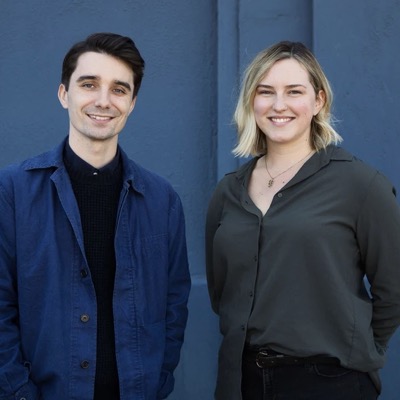
Illustrating Balanced and Inclusive Teams
Sara VanSlyke & Trace Byrd Designers Atlassian
The influence of brands on society can’t be underestimated. The technology industry in particular is extremely unbalanced when it comes to diversity, and there is little doubt that a lack of representation in tech brands plays a role — if people don't see themselves represented in tech branding, it’s unlikely they’d consider tech a welcoming place to work.
As a member of the technology community, Atlassian realized its responsibility to depict a more diverse and inclusive vision of collaboration. The Creative Team addressed this opportunity in a number of ways as part of a major brand refresh and found that illustration could be an especially powerful tool to support their effort.
In this session, Sara and Trace from Atlassian, discuss their journey towards creating an illustration system that reflects more inclusive teamwork. They will share some of the challenges they’ve encountered in building a representative brand and lessons they’ve learned along the way.
Read More

Putting Research In Its Place
Leisa Reichelt Head of Research and Insights Atlassian
Read More
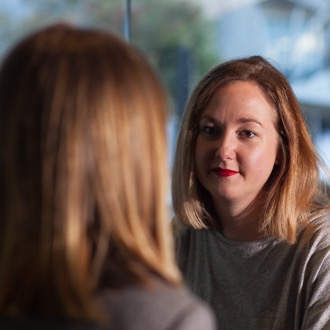
Evolving an organisation's culture through design
Lucie Paterson Product Manager ACMI
I’ll show you how a small team can have high impact and transform products and services into experiences our visitors expect and love us for. Drawing on examples across user experience design, service design and customer experience design I’ll illustrate how while developing products we are gradually changing the culture of the organisation into one that is constantly evolving through risk taking, experimenting and working at pace.
Read More

Doing Good (Design) in Government
Kate Conrick Service & Experience Designer Oakton
It can often be difficult to see what true transformation of government or public services really looks like and it can be very challenging to make a change, and see the impact you're making on people's lives. But it's worth it. I'm here to talk about what we can do, and how we can make real change - even with the machinery of government sometimes acting against us.
Read More

Outsourcing design. The good, bad and ugly
Chris Stonestreet User Experience Manager NIB Health Funds
Outsourcing is a behaviour we’re all familiar with, we outsource our manufacturing, textiles and even food production but our attitude toward this paints a different story.
As organisations start to or already see the value in design and investment is spent to grow internal design teams. There’s always the challenge of not enough troops on the ground to cover all the work.
There can be benefits to outsourcing design work but these do not out weight the risks.
Read More

Design for the long term
Andy Polaine Regional Design Director APAC Fjord
Move fast and break things, sprint, be lean, be agile, ship, iterate. These are the mantras of our digital design world and they have jettisoned us out of the fossilised age of hierarchical edifices and waterfall management. But they have come at the cost of long-term thinking and deep reflection. Rapid iteration and half-broken MVPs are fine for First World problems, but a different kind of lens is critical digital when these platforms and services are woven into the fabric of society.
Many of the essential services in our lives – finance, mobility, communications, healthcare, welfare – are services that existed long before any of us were born. They will be around long after we retire and well beyond our lifetimes. Designing them requires care and humility. In this talk Andy draws upon the fields of space exploration, landscape gardening and architecture to argue the case for thinking long and why this should be part of every designer’s mindset.
Read More
Our venue
Design 2018 will again be held in the ANZ Pavilion at the iconic Arts Centre Melbourne, right on the Yarra in Southbank.
ANZ Pavilion,
Arts Centre Melbourne,
100 St Kilda Road, Melbourne
Getting there:
With excellent public transport connections right outside, and Flinders Street Station right across the bridge, it's our best connected location yet.
Accommodation:
If you're coming from out of town, there are many hotel and serviced apartments style accomodation options in Southbank, and otherwise close by. We have for some time put our speakers up at the Mantra Southbank, and stay there ourselves.
Partners
At Web Directions we work closely with partners to help make our events even better. Sponsor our coffee, reception, recharge station, or other valued activities and start or grow your relationship with our highly qualified audience.
Contact us for more on how we work can work with you to help you be even more awesome.
Key Partners
Meetup Muster Partners
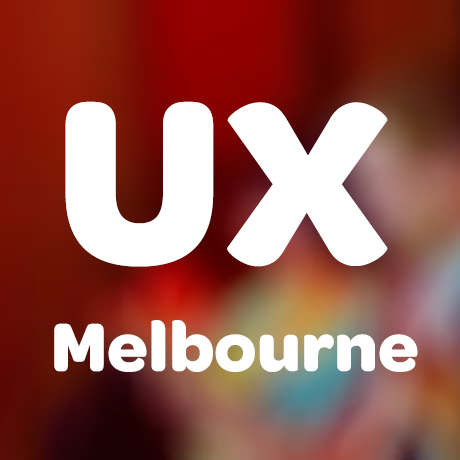

Season PassesChoose a pass across 2, or all 3 of our major 2020 events, and get a Gold ticket which includes conference video, speaker dinner at each, and more. You can even pay quarterly to manage cashflow. Just register then contact us and we'll set it all up. Passes are for a single named attendee across all events, and are not transferable between attendees. For teams we have great group pricing, contact us for more. |
Complete Season Pass
|
Three Conference Pass
|
Two Conference Pass
|
|
|
|
|
Find the season pass for you
Complete Season Pass
A Gold ticket to every one of our main 2020 conferences
Bonus Silver ticket to our Design Leaders and Code Leaders conferences
- $3,495
before Feb. 28
A Gold ticket to all three of our main 2020 conferences
Bonus Silver ticket to a choice of Code Leaders or Design Leaders
- $2,995
before Feb. 28
Two Conference Pass
A Gold ticket to your choice of two of our main 2020 conferences
- $1,995
before Feb. 28
Praise for past Web Directions events

Web Directions is the must-attend event of the year for anyone serious about web development.
Phil Whitehouse,
Innovation Lead DigitasLBi

I’ve been admiring the Web Directions events for years, and was honored to be part… What a fantastic event!
Ethan Marcotte,
inventor "responsive Web design"

Out of any conference, Web Directions is far and away our favourite
Dave Greiner,
founder Campaign Monitor
About Us
Co-founded and now run by John Allsopp, Web Directions has for nearly 20 years brought together leading developers, engineers, visual, IxD, UX and product designers, Art and Creative Directors, product managers indeed everyone involved in producing web and digital products to learn from one another, and the World's leading experts across this vast field.
We spend our lives thinking about what comes next, keeping up with trends in technology, practices and processes, and filtering the hype, to make sure you don't miss trends that matter, and don't waste time on hype that doesn't.
We promise attending one of our events will leave you significantly better versed in the challenges you face day to day, and in solutions for addressing them.

John Allsopp
John Allsopp has been working on the Web for nearly 30 years. He's been responsible for innovative developer tools such as Style Master, X-Ray and many more. He's spoken at numerous conferences around the World and delivered dozens of workshops in that time as well.
His writing includes two books, including Developing With Web Standards and countless articles and tutorials in print and online publications.
His "A Dao of Web Design" published in 2000 is cited by Ethan Marcotte as a key influence in the development of Responsive Web Design, who's acclaimed article in 2010 begins by quoting John in detail, and by Jeremy Keith as "a manifesto for anyone working on the Web".
Code of Conduct
For over a decade, we've worked hard to create inclusive, fun, inspring and safe events for the Web Industry.
As part of our commitment to these values, we've adopted a code of conduct for all involved: ourselves, our speakers, our partners and our audience.
If you have any concern or feedback, please don't hesitate to contact us.